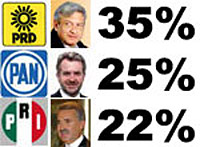 |
 |
 |
 Editorials | August 2005 Editorials | August 2005  
The Changing Face of Presidential Campaigns in Mexico
 Carlos Luken - MexiData.info Carlos Luken - MexiData.info


| | Obradoor leads according to face-to-face interviews to 1,515 Mexican adults, conducted from Aug. 19 to Aug. 22, 2005. Margin of error is 2.5 per cent. |
Mexico’s presidential race has started prematurely, with the nation’s three major parties beginning their awkward campaigns simultaneously and in many of the same cities.

National Action Party (PAN) hopefuls Santiago Creel and Felipe Calderon had barely departed on individual stumps to PAN’s traditional stronghold of Baja California, when Andres Manuel Lopez Obrador, the Democratic Revolution Party (PRD) frontrunner, made a series of campaign appearances in the state. On his heels came barnstorming Institutional Revolutionary Party (PRI) president Carlos Madrazo, another presidential contender.

But other than the major primary candidates converging on the region, no other coincidences were evident as political, ideological and strategic differences erupted in their speeches.

While Creel and Calderon organized low-key internal PAN meetings, which were virtually ignored by the media, Lopez Obrador staged crowded rallies attended by thousands, many of whom were undoubtedly curious onlookers rather than party followers.

But Roberto Madrazo and the PRI outdid everyone, with their old-time style of political action and organization that managed to mobilize upwards of 20,000 attendees who filled one of Tijuana’s large bullrings.

Roberto Madrazo, as president of the PRI, has maneuvered the party’s still impressive machinery and capital towards recapturing power and its corrupt status quo lost with the 2000 elections. Madrazo is straightforward in his intentions, and the PRI still has a well-oiled organization that can marshal and manipulate persons towards assemblies or voting places, as was seen in Tijuana.

Lopez Obrador, a PRI defector whose strategies and aims are like Madrazo’s, is a former mayor of Mexico City who craftily used populism and demagogic propaganda to gain national recognition. Emphasizing his populist agenda, Lopez Obrador is promising heavy spending on public work projects, money giveaways to the poor and elderly, free milk to mothers, and lower electricity rates to the hard-pressed inhabitants of northern Mexico.

The PAN contest is boiling down to a two-man race between former Fox cabinet ministers Creel (Interior) and Calderon (Energy). Although Creel initially had a commanding lead, Calderon is nibbling away and closing the gap on the eve of PAN’s regional primaries in September and October.

As a former congressman and president of the PAN, Calderon does not expect the electorate to give any party a congressional majority in 2006, which means a coalition-style government will be required.

Although Creel’s views have been kept private, he is expected to follow a similar strategy in order to avoid another six-year congressional stalemate as experienced during the Fox administration.

Contrary to the PRI and PRD, the PAN campaigning has been low key to date. However on September 8 the party will begin nationally televised debates between pre-candidates.

Even minor parties are jockeying for position, as their only possibilities for success will be through negotiated alliances with major parties in order to gain proportional political positions. Small leftwing parties are leaning toward a token candidacy for three time presidential candidate Cuauhtemoc Cardenas, whose PRD chances have been steamrolled by Lopez Obrador.

The Mexican Ecological Green Party, whose image has been badly tarnished by scandals, will most likely try to again align itself with the PRI. The centrist Democratic Convergence is still positioning itself, interviewing highbrow candidates like former Foreign Minister Jorge Castañeda, National University dean Juan Ramon de la Fuente, and Latin America’s richest man, Carlos Slim, among others.

Considering the flagrant partisanship exhibited in politician’s behavior, the Mexican electorate has grown cynical and thus ignores most candidate’s ideological rhetoric, accepting that once in power the politicians will pursue their personal interests. Thus many undecided voters are seeking a personality, someone whom they hope might truly help with basic problems such as jobs for the unemployed and needed public safety.

All parties have their faithful constituencies, and in any given election together these total around 60 percent of the vote. The remaining ballots have traditionally been cast by non-aligned electors, sometimes called the “undecided” or “protest voters,” or maybe in the 2006 elections “desperate voters.”

For all of Mexico’s problems, the 2006 presidential campaign will still not be a battle of issues but one of personalities, style and negotiations. In order for a party or coalition to have any chance of success in Mexico’s caustic political arena, many promises will not be kept while ideological and policy issues will have to be negotiated or altered, creating a rarified political agenda that may provide some advances but will also produce more confusion and distrust.

Carlos Luken, a MexiData.info columnist, is a Mexico-based businessman and consultant. He can be reached via e-mail at ilcmex@yahoo.com. | 
 | |
 |



